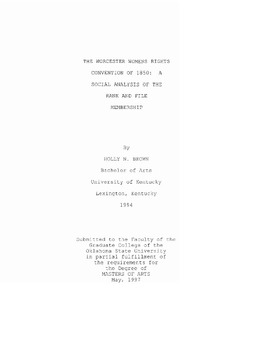| dc.contributor.author | Brown, Holly N. | |
| dc.date.accessioned | 2014-09-29T19:39:21Z | |
| dc.date.available | 2014-09-29T19:39:21Z | |
| dc.date.issued | 1997-05-01 | |
| dc.identifier.uri | https://hdl.handle.net/11244/12200 | |
| dc.description.abstract | This study analyzed the membership of the Worcester Women's Rights Convention of 1850, to compare the major characteristics of this group to the general population of Worcester, Massachusetts in 1850. The members of the convention were urban, white, Protestant and different from the general population. The city of Worcester's population was much more diverse. Within the membership group it was found that they were not all of the same socio-economic background. By dividing the one group into three categories--antislavery organizers, women, and men--the study found that there were working class as well as upper and middle class individuals at the convention. The class diversity occurred almost wholly among women. The bulk of the research of this study was conducted at the American Antiquarian Society in Worcester, Massachusetts. Sources were also located at the Worcester Historical Museum and the Worcester Room at the Worcester Public Library. | |
| dc.format | application/pdf | |
| dc.language | en_US | |
| dc.publisher | Oklahoma State University | |
| dc.rights | Copyright is held by the author who has granted the Oklahoma State University Library the non-exclusive right to share this material in its institutional repository. Contact Digital Library Services at lib-dls@okstate.edu or 405-744-9161 for the permission policy on the use, reproduction or distribution of this material. | |
| dc.title | Worcester Womens Rights Convention of 1850: a Social Analysis of the Rank and File Membership | |
| dc.type | text | |
| osu.filename | Thesis-1997-B878w.pdf | |
| osu.accesstype | Open Access | |
| dc.type.genre | Thesis | |
